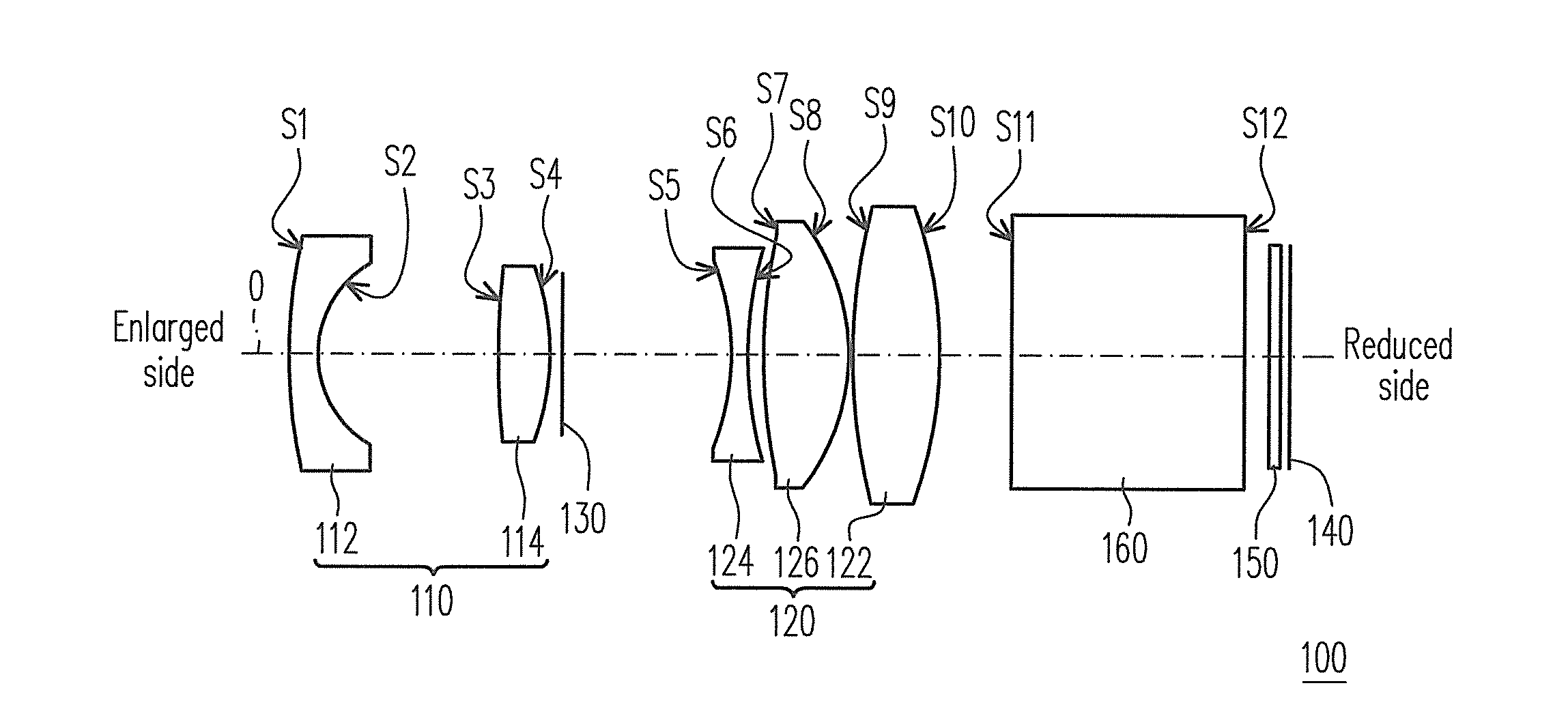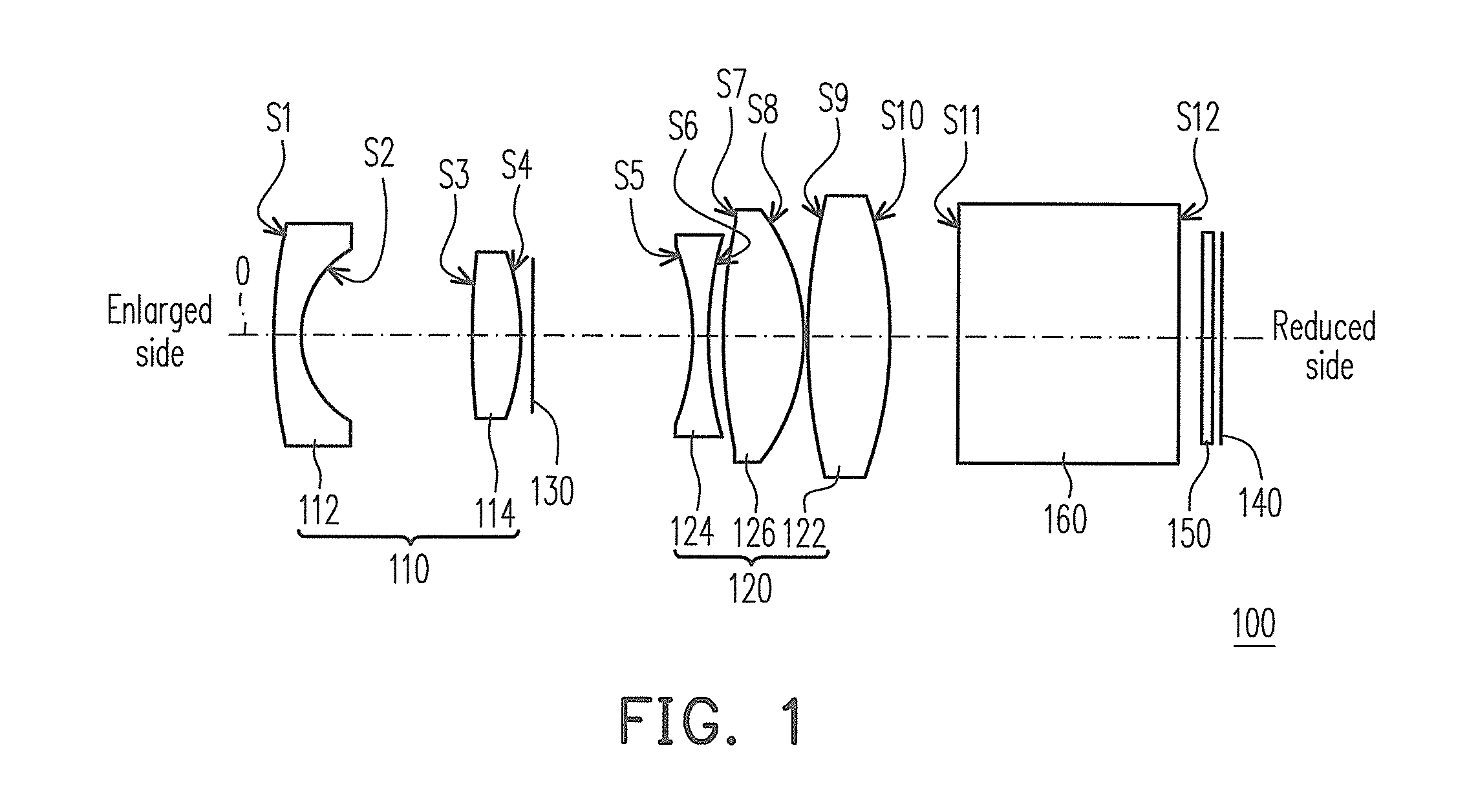Fixed-focus lens
a fixed-focus lens and lens body technology, applied in the field of lenses, can solve the problems of image aberration, large overall size of the lens, and large increase in the fabrication cost of the lens, so as to achieve optimal imaging quality, reduce aberration, and large aperture
- Summary
- Abstract
- Description
- Claims
- Application Information
AI Technical Summary
Benefits of technology
Problems solved by technology
Method used
Image
Examples
first embodiment
[0037]FIG. 1 is a structure diagram of a fixed-focus lens according to the first embodiment of the invention. Referring to FIG. 1, in the present embodiment, the fixed-focus lens 100 is disposed between an enlarged side and a reduced side and includes a first lens group 110 and a second lens group 120 sequentially arranged from the enlarged side to the reduced side. The first lens group 110 includes a lens 112, wherein the lens 112 is an aspheric lens. The second lens group 120 has a positive dioptre and is disposed between the first lens group 110 and the reduced side. The second lens group 120 includes a lens 122, wherein the lens 122 is an aspheric lens.
[0038]In the present embodiment, the fixed-focus lens 100 focuses by moving the first lens group 110 and the second lens group 120, and the fixed-focus lens 100 satisfies 0.1100, f1 is the effective focal length (EFL) of the first lens group 110, f2 is the EFL of the second lens group 120, L is the total length of the fixed-focus ...
second embodiment
[0052]FIG. 3 is a structure diagram of a fixed-focus lens according to the second embodiment of the invention. Referring to FIG. 3, in the present embodiment, the fixed-focus lens 200 is disposed between an enlarged side and a reduced side and includes a first lens group 210 and a second lens group 220 sequentially arranged from the enlarged side to the reduced side. The first lens group 210 includes a lens 212, wherein the lens 212 is an aspheric lens. The second lens group 220 has a positive dioptre and is disposed between the first lens group 210 and the reduced side. The second lens group 220 includes a lens 222, wherein the lens 222 is an aspheric lens. The fixed-focus lens 200 focuses by moving the first lens group 210 and the second lens group 220.
[0053]In the present embodiment, the lens 222 has a negative dioptre, and the lens 222 is a lens in the second lens group 220 that is closest to the aperture diaphragm 130. Besides, the fixed-focus lens 200 satisfies 0.2|f / f1|200, f...
third embodiment
[0064]FIG. 5 is a structure diagram of a fixed-focus lens according to the third embodiment of the invention. Referring to FIG. 5, in the present embodiment, the fixed-focus lens 300 is disposed between an enlarged side and a reduced side and includes a first lens group 310 and a second lens group 320 sequentially arranged from the enlarged side to the reduced side. The first lens group 310 includes a lens 312, wherein the lens 312 is an aspheric lens. The second lens group 320 has a positive dioptre and is disposed between the first lens group 310 and the reduced side. The second lens group 320 includes a lens 322, wherein the lens 322 is an aspheric lens. The fixed-focus lens 300 focuses by moving the first lens group 310 and the second lens group 320.
[0065]In the present embodiment, the lens 322 has a negative dioptre, and the lens 322 is a lens in the second lens group 320 that is closest to the aperture diaphragm 130. Besides, the fixed-focus lens 300 satisfies 0.2300, f1 is th...
PUM
 Login to View More
Login to View More Abstract
Description
Claims
Application Information
 Login to View More
Login to View More - R&D
- Intellectual Property
- Life Sciences
- Materials
- Tech Scout
- Unparalleled Data Quality
- Higher Quality Content
- 60% Fewer Hallucinations
Browse by: Latest US Patents, China's latest patents, Technical Efficacy Thesaurus, Application Domain, Technology Topic, Popular Technical Reports.
© 2025 PatSnap. All rights reserved.Legal|Privacy policy|Modern Slavery Act Transparency Statement|Sitemap|About US| Contact US: help@patsnap.com



